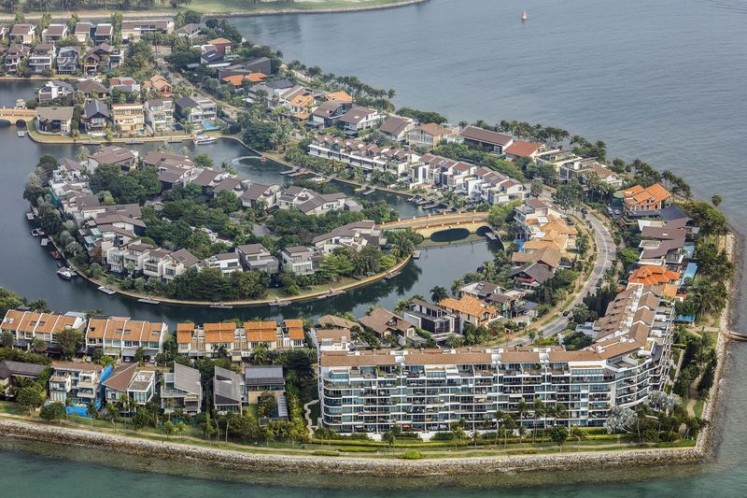Popular Reads
Top Results
Can't find what you're looking for?
View all search resultsPopular Reads
Top Results
Can't find what you're looking for?
View all search resultsMoving to Singapore? What you need to know to find a place to live
What you need to know when house-hunting in the high-tech center of international finance.
Change text size
Gift Premium Articles
to Anyone
A
lthough it’s only 278 square miles in size, Singapore has an outsized reputation in finance. The island city-state, which gained independence in 1965, has woven grand century-old architecture and modern high-rises together into an alluring high-tech business center.
“It ticks a lot of boxes,” says Alice Tan, Singapore-based head of consultancy and research at Knight Frank LLP. “Language, schooling, safety. And it’s a key financial business hub, with many companies having their Asian headquarters here.” (Google Inc. and Uber Technologies Inc. both recently expanded operations on the island.)
When the government further tightened curbs to cool the overheated property market in 2013, the measures led to a 12 percent decline in home prices, and for the past four years it’s been a buyer’s market. But recent indicators, including a reversal in prices and buoyant home sales, show a recovery under way. In August the 10,300-square-foot penthouse at the Sculptura Ardmore condominium, located in the Core Central, sold for an estimated S$60 million ($44 million)—a record—according to local media reports.
“Luxury home prices fell by up to 25 percent over the last few years,” says Alan Cheong, senior director at brokerage Savills Plc. “But they have been the first to turn around.” A home in a prime location that’s at least 2,000 square feet will run about S$3 million.
Buyers can choose between buying on leasehold land, normally available for a 99-year term, and freehold land, which is held in perpetuity but costs an additional 15 percent to 20 percent. More than half the 356,000 private homes in the city have been built since the millennium, which means there’s a steady supply of new units at the top end of the market.
Read also: Melbourne retains world's most liveable city crown
Where to house hunt
A house on Sentosa Island recently sold for S$1,775 per sq. ft., well below prices at the market’s peak in 2012 of S$3,214 per sq. ft., according to Li at Cushman & Wakefield. (Bloomberg/Darren Soh)Housing in Singapore is a combination of pure residential developments and mixed-use projects that include offices and malls along with apartments. Two of the priciest sectors are the prime shopping area of Orchard Road and Marina Bay, which surrounds the business district that spreads across the central and southern parts of the city. Prices there can run to S$2,300 per square foot, while space in older buildings in these areas goes for S$750 per sq. ft.
The farther from the city center, the more space buyers get for their money, and developers have begun competing to provide the most lavish amenities. The Parc Olympia condominium, five minutes from Changi Airport, has private compounds with their own rock-climbing wall, a golf driving range, and a skateboard ramp. The Jewel@Buangkok, in the northeast residential town of Sengkang, offers pet-grooming stations, pools, Jacuzzis, tennis courts, and playgrounds. Prices for both developments range from S$550,000 for a one-bedroom to about S$2.2 million for a four-bedroom.
Of course, distance is relative. The island is only about 25 miles wide, and the nation’s subway system and highways help keep commute times, even by public transport, to less than an hour.
For those looking for more of a vacation vibe, there’s Sentosa Island, the resort off Singapore’s southern coast, which is home to a Universal Studios theme park and several popular beaches. Christine Li, a director of research at Cushman & Wakefield, says houses here sell for about S$1,709 per sq. ft.
It’s relatively easy to buy a house in Singapore, but foreigners must shell out a 15 percent tax for home purchases in the city, in addition to the 3 percent citizens pay. Bungalows in good condition run about S$1,152 per sq. ft.
Read also: The best and worst countries to live and work in, according to expats
Apartments, town houses, and condos
Rentals are also popular, and prices have recently sagged. They can range from S$5,000 to S$10,000 a month for an apartment in the city center, and a house in good condition goes for S$25,000, says Boon Hoe Leong, chief operating officer at List Sotheby’s International Realty.
High-rises are geared to the tropical lifestyle, with pools, air-conditioned gyms, and underground parking. The swankiest downtown buildings specialize in bespoke details such as a glass-walled lap pool on your balcony, a rooftop Jacuzzi, and a special elevator for your car, each for about S$10 million.
Among the plush properties under construction is one in Wallich Residence, a three-story penthouse atop the 950-foot-tall Tanjong Pagar Centre on the edge of the financial district. Built by GuocoLand Ltd. and advertised by Sotheby’s, the 21,000-sq.-ft., five-bedroom home includes plans for a rooftop infinity pool overlooking the Singapore Strait and high-tech entertainment spaces, all for an advertised price of S$108 million. It’s scheduled to be completed this year.
Read also: Four cities in Indonesia where you can travel by foot
Old-world appeal
For many, the peak of elegance is to rent one of the old colonial “black-and-white” houses that have been preserved in areas across the island such as Nassim Hill and Goodwood Hill.
These large, airy homes come with big terraces, and many have separate servants’ quarters. They’re mostly owned and leased by the government and sit in leafy tropical gardens, a true luxury in congested Singapore.
Prices tend to range from about S$25,000 to S$50,000 a month for properties with five or more bedrooms. “With rents declining, expats have plenty of choices,” Sotheby’s Boon says.












